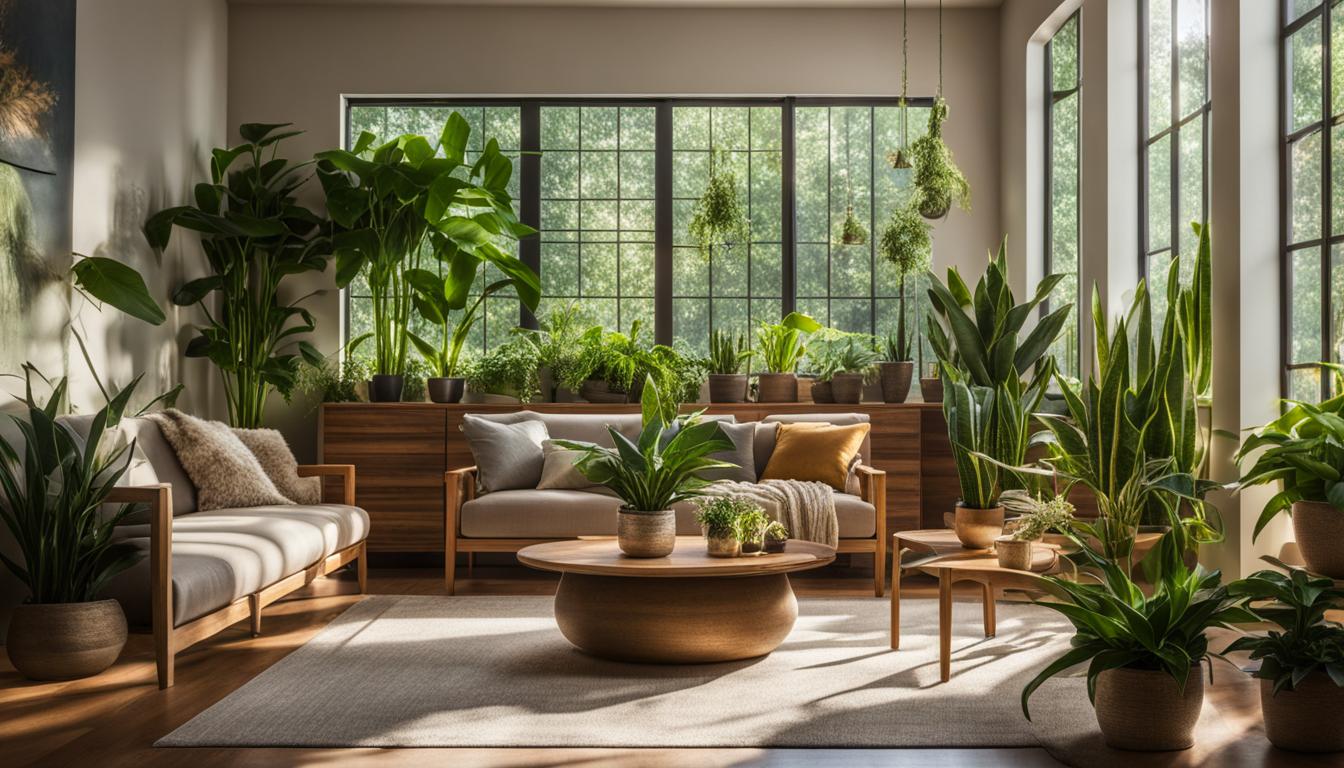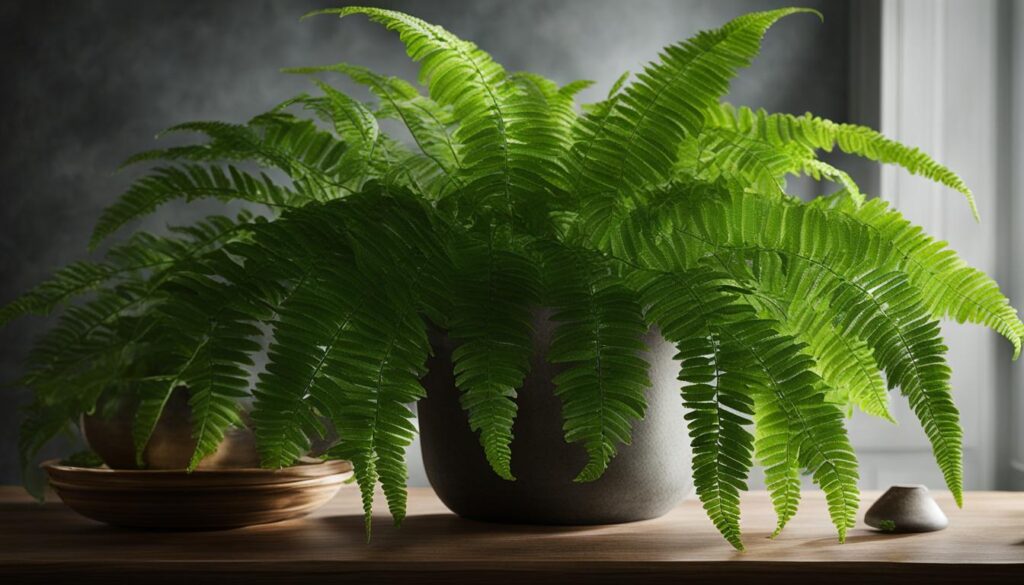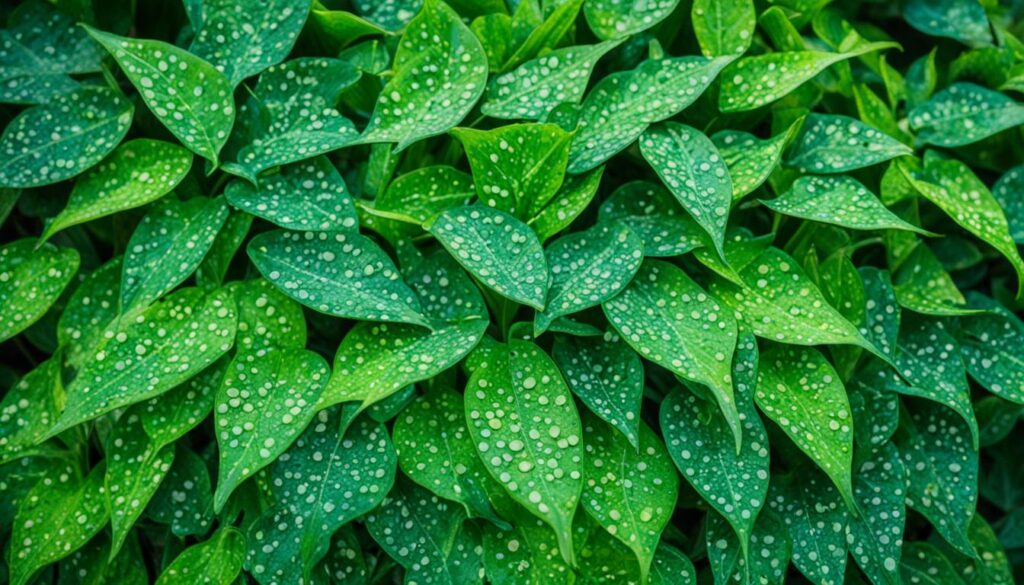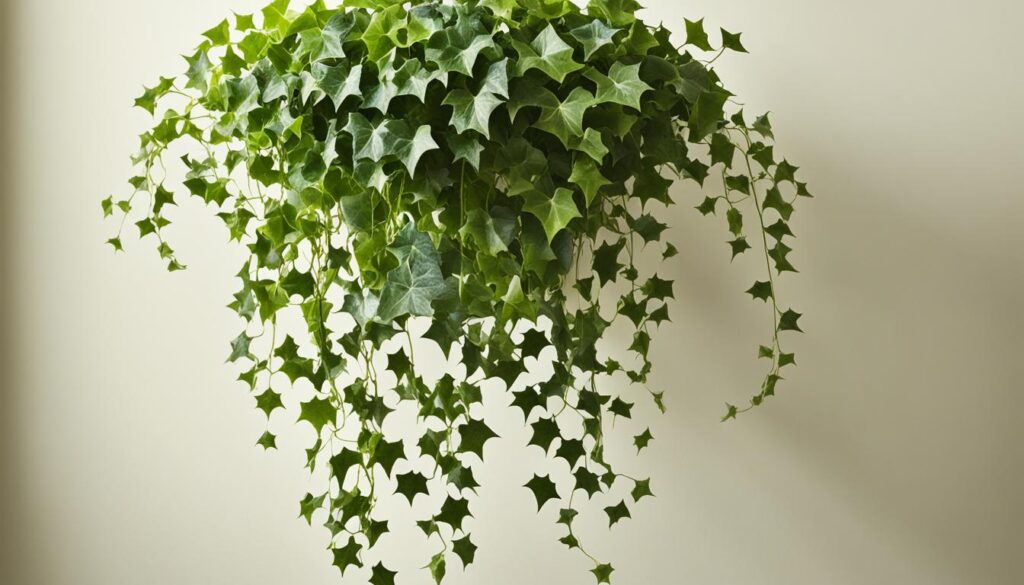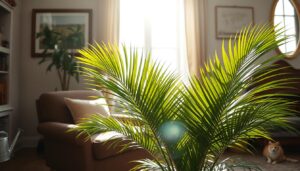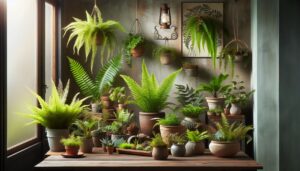Are you struggling to find the perfect plants that can thrive in low light conditions? Do you think that there are limited options when it comes to adding greenery to your office space or spacious rooms? Well, think again!
Many plant varieties have adapted to survive and even thrive in environments with minimal natural light. In this article, I will introduce you to 10 stunning plants that are perfect for low light conditions.
Whether you want to spruce up your office, add life to your hanging baskets, or bring some greenery into your spacious rooms, these plants will not only survive but also enhance the overall aesthetics of your space.
So, get ready to explore the world of low light plants and discover how you can transform your space into a lush, green oasis!
Key Takeaways:
- Low light conditions don’t have to limit your plant choices.
- There are 10 perfect plant varieties for your office, hanging baskets, and spacious rooms.
- These plants not only survive but also enhance the aesthetics of your space.
- Discover how you can transform your space into a lush, green oasis.
- Bring life and beauty to low light environments with these stunning plant options.
Understanding Low Light Conditions
Do you have a space in your home or office that lacks natural light? Understanding low light conditions is essential for choosing the right plants that can thrive in these environments.
How to Determine the Light Levels in Your Space
Before selecting plants for low light conditions, it’s crucial to assess the amount of light available in your space. Here are some simple methods to determine the light levels:
- Observe the natural light: Spend some time in the area during different times of the day and note the intensity and duration of the sunlight. Is the space bright and sunny, dimly lit, or mostly shaded?
- Consider the direction of windows: The orientation and placement of windows can significantly affect the light levels. South-facing windows generally receive the most intense sunlight, while north-facing windows have lower light levels.
- Assess the distance from the window: Plants placed near windows receive more light compared to those positioned further away. Take into account the distance between the available light source and the intended plant location.
- Use a light meter: Light meters are handy devices that measure the intensity of light. They provide precise readings, which can help you determine the exact light levels in your space.
By carefully evaluating these factors, you can have a better understanding of the light conditions in your space and make informed decisions when choosing low light plants.
Pothos: The Versatile Low Light Trailing Plant
When it comes to low light environments, one plant that thrives exceptionally well is the Pothos. With its cascading vines and vibrant leaves, Pothos is a popular choice for adding a touch of greenery to any space. Whether you have a dimly lit office, a cozy living room, or even a bathroom with limited natural light, Pothos can bring life and beauty to these areas.
What makes Pothos such a versatile plant is its ability to adapt and survive in low light conditions. This plant can tolerate a wide range of light levels, making it suitable for various indoor spaces. Whether you have a north-facing window with minimal sunlight or a room with only artificial lighting, Pothos can continue to thrive and bring a touch of nature into your surroundings.
The Benefits of Pothos in Low Light Environments
Pothos offers several benefits when grown in low light environments. Here are some key advantages of having Pothos in your space:
- Air purification: Pothos has been shown to effectively filter toxins from the air, improving indoor air quality. This is particularly beneficial in low light environments where ventilation may be limited.
- Low maintenance: Pothos is an easy-care plant that requires minimal attention. It can tolerate irregular watering and can even thrive in low humidity conditions.
- Natural decor: With its cascading vines, Pothos adds a touch of natural beauty to any space. Whether placed on a shelf, hung from a basket, or trained to climb a trellis, Pothos can enhance the aesthetic appeal of your surroundings.
- Easy propagation: Pothos is known for its ability to propagate easily. You can grow new plants from cuttings, making it a cost-effective way to expand your green collection or share plants with friends and family.
Whether you’re looking to add some greenery to your office, bring life to your hanging baskets, or liven up a spacious room with limited natural light, Pothos is the perfect choice. Its versatility, low light tolerance, and stunning foliage make it a top pick for plant enthusiasts of all levels of experience.
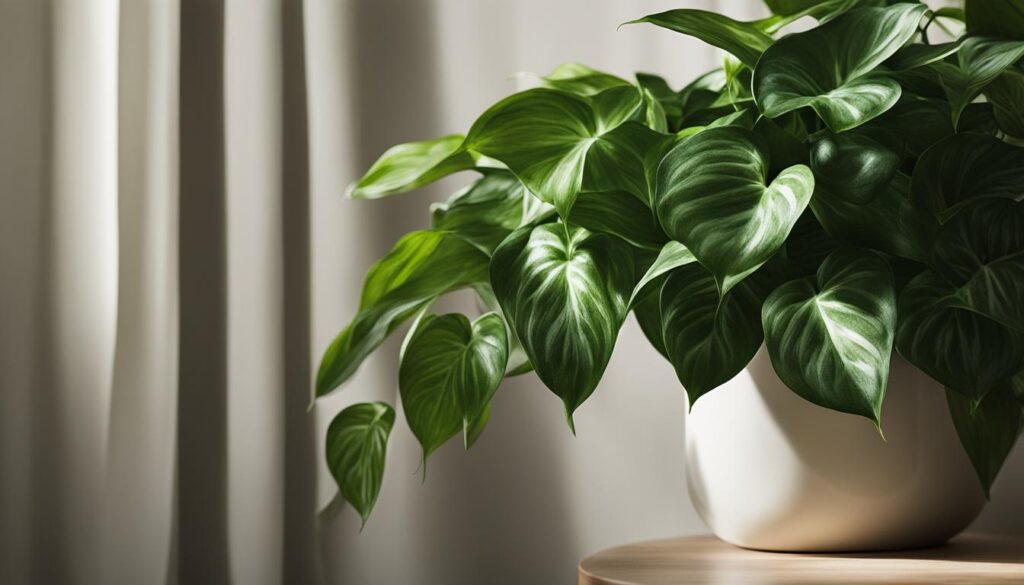
Spider Plant: The Ideal Low Light Hanging Plant
How Spider Plants Thrive in Low Light Conditions
Spider plants (Chlorophytum comosum) are not only visually appealing with their long, arching leaves, but they also make the perfect addition to any low light space, especially when hanging from baskets or pots. These versatile plants have the ability to adapt and thrive in various light conditions, making them an excellent choice for those who want to add a touch of greenery to their dimly lit rooms or offices.
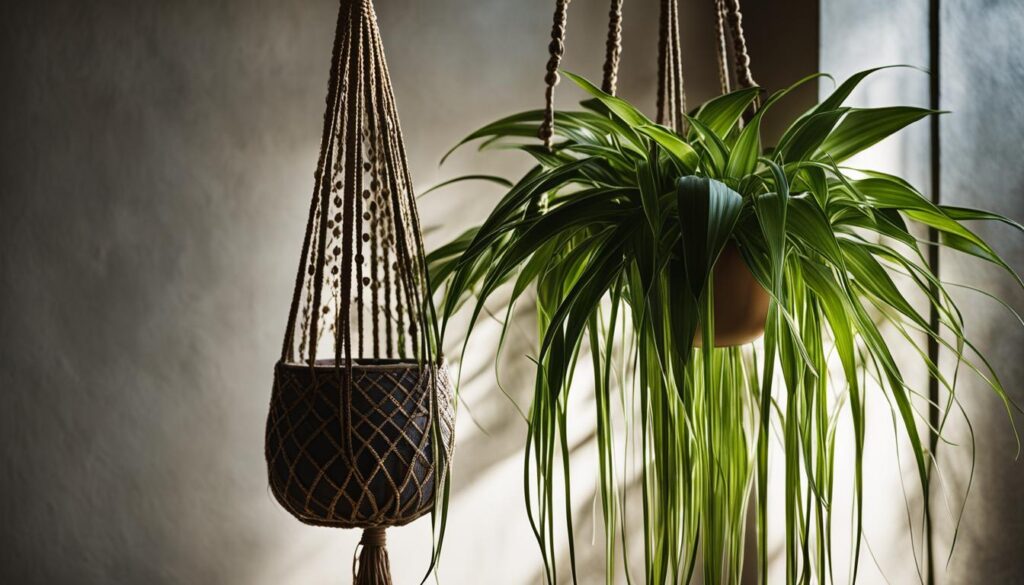
Spider plants are known for their resilience and ability to tolerate low light levels. This is because they have adapted to grow naturally under the dense canopy of trees in their native tropical regions. Their leaves are thin and flexible, allowing them to absorb and utilize every available bit of light. Additionally, spider plants have the unique ability to perform photosynthesis in low light conditions, making them well-suited for environments where natural light is limited.
When it comes to caring for spider plants in low light conditions, it’s important to keep a few key factors in mind. Firstly, these plants prefer indirect or filtered light rather than direct sunlight, as excessive sunlight can scorch their leaves. Placing them near a north-facing window or away from direct sunlight is ideal.
Spider plants also appreciate consistent moisture but are tolerant of occasional neglect. It’s important to ensure that the soil is well-drained to avoid overwatering, as this can lead to root rot. Regular watering and allowing the soil to dry out slightly between watering sessions will help keep your spider plant healthy.
In addition to being low light champions, spider plants also have the added benefit of being air purifiers. They can help remove toxins, such as formaldehyde and xylene, from the air, making them a great choice for spaces with poor air quality or limited ventilation.
To summarize, spider plants are well-suited for low light conditions due to their natural adaptation to low light environments and their ability to perform photosynthesis under limited light. With their graceful foliage and air purifying qualities, they make an excellent choice for hanging baskets or pots in dimly lit rooms or offices.
Peace Lily: A Low Light Large Plant for Elegance
When it comes to creating an elegant and visually striking atmosphere in low light environments, the Peace Lily is an excellent choice. This large plant is known for its lush green leaves and beautiful white flowers, adding a touch of sophistication to any space.
The Peace Lily thrives in low light conditions, making it ideal for rooms with minimal natural sunlight. It can tolerate dim corners and shady areas, making it a versatile option for various indoor spaces.
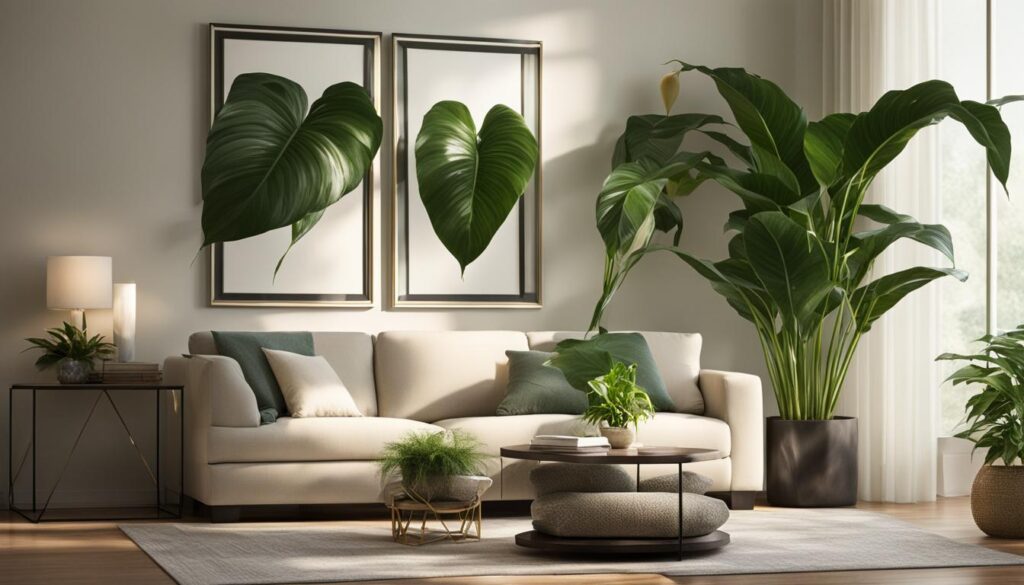
The Stunning Features of Peace Lilies in Low Light
One of the standout features of Peace Lilies is their ability to purify the air. These plants are known to effectively remove harmful toxins such as benzene, formaldehyde, and trichloroethylene from the surrounding environment, improving indoor air quality and creating a healthier living or working space.
Additionally, Peace Lilies are relatively low maintenance, making them a popular choice for busy individuals or those with a limited green thumb. They require minimal watering and can tolerate occasional neglect, making them a forgiving option for beginners or those with a hectic schedule.
The Peace Lily also has a unique ability to let you know when it’s time to water. When the plant needs watering, the leaves will droop, serving as a visual cue to give it a drink. Once watered, the leaves will quickly regain their upright position, making it easy to gauge when the plant needs attention.
Furthermore, the Peace Lily’s elegant white flowers are not only visually appealing but also have a symbolic meaning. These flowers are often associated with purity, innocence, and peace, adding a touch of tranquility to any space they adorn.
Overall, the Peace Lily is a stunning choice for those looking to bring beauty, elegance, and improved air quality to their low light indoor spaces. Whether placed in an office, bedroom, or living room, this large plant is sure to make a statement and create a serene atmosphere.
| Feature | Benefits |
|---|---|
| Air purifying | Removes harmful toxins from the environment |
| Low maintenance | Requires minimal watering and care |
| Visual cue for watering | Leaves droop to indicate the need for water |
| Symbolic flowers | Adds a touch of tranquility to the space |
With its stunning features and ability to thrive in low light conditions, the Peace Lily is an excellent choice for anyone looking to create an elegant and serene atmosphere in their indoor spaces.
Snake Plant: The Tall and Tough Low Light Champion
When it comes to thriving in low light conditions, the Snake Plant (Sansevieria) is a true champion. With its tall and striking leaves, this plant not only adds beauty to any space but also requires minimal care and attention.
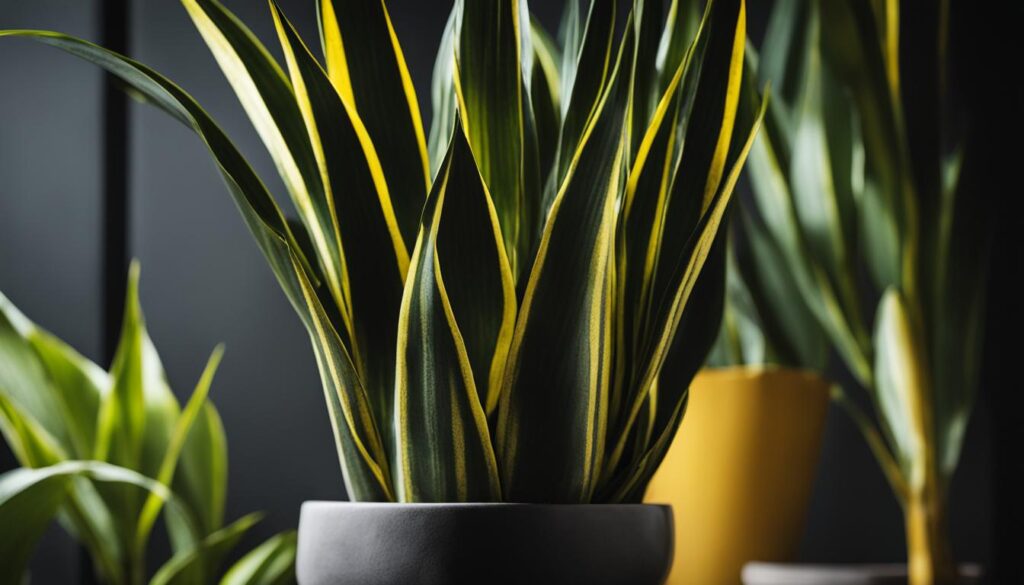
The Resilience and Beauty of Snake Plants in Low Light
Snake Plants are known for their exceptional resilience, making them the perfect choice for those looking to bring greenery into dimly lit areas. These plants have adapted to survive in the understory of tropical forests, where sunlight is limited. Their ability to thrive in low light conditions is attributed to their unique photosynthetic process, which enables them to convert carbon dioxide into oxygen even in the absence of direct sunlight.
One of the remarkable features of Snake Plants is their ability to purify the air. These plants filter out toxins, such as formaldehyde and benzene, commonly found in indoor environments. This makes them a great addition to bedrooms, living rooms, and any space where clean and fresh air is desired.
Another advantage of Snake Plants is their ability to tolerate neglect. They are highly adaptable and can withstand inconsistent watering and extended periods of low light. This makes them an excellent choice for busy individuals or those who may not have green thumbs.
The beauty of Snake Plants lies in their architectural leaves. The tall, upright foliage adds a touch of elegance to any room. With various cultivars available, you can choose from different leaf shapes and patterns to suit your personal style and interior design.
Whether you’re decorating an office, a spacious room, or a hanging basket, Snake Plants are a versatile and low-maintenance choice that will thrive in low light conditions. With their resilience and beauty, these plants are sure to bring life and elegance to your surroundings.
ZZ Plant: The Ultimate Low Maintenance Office Plant
When it comes to finding the perfect plant for your low light office environment, look no further than the ZZ Plant. As a low maintenance option, this plant is the ideal choice for busy professionals who want to enjoy the beauty and benefits of greenery without the hassle of constant care.
The ZZ Plant, also known as Zamioculcas Zamiifolia, is native to Eastern Africa and has become increasingly popular due to its ability to thrive in low light conditions. With its dark, glossy leaves and upright growth habit, the ZZ Plant adds a touch of elegance and sophistication to any office space.
One of the main advantages of the ZZ Plant is its exceptional tolerance to neglect. This plant can survive in low light environments with minimal watering, making it the perfect choice for those who are often out of the office or simply don’t have a green thumb. Even if you forget to water it for weeks, the ZZ Plant will continue to flourish.
Another benefit of the ZZ Plant is its air-purifying qualities. It can help remove toxins such as benzene, toluene, and xylene from the air, creating a healthier and more productive work environment. In addition, the ZZ Plant releases oxygen at night, making it an excellent choice for offices that are occupied during the evening hours.
With its distinct, glossy foliage and low maintenance requirements, the ZZ Plant is a top choice for adding a touch of greenery to your office space. Whether placed on a desk, shelf, or in a corner, this plant will thrive in low light conditions and bring beauty and tranquility to your workspace.
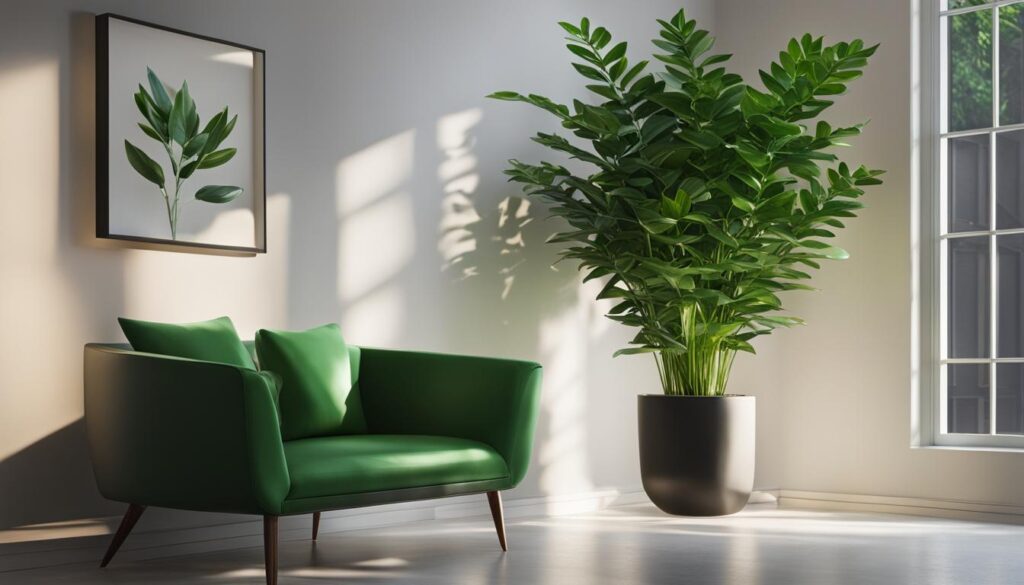
Philodendron: The Heart-Leafed Low Light Favorite
When it comes to low light houseplants, one that stands out for its beauty and resilience is the philodendron. With their heart-shaped leaves and lush foliage, philodendrons bring a touch of greenery and elegance to any low light environment.
Philodendrons are well-known for their adaptability and ability to thrive in low light conditions, making them a popular choice for homes and offices alike. These versatile plants can add a touch of nature to dimly lit corners, making them perfect for rooms with limited natural sunlight.
One of the key factors that make philodendrons a favorite among plant enthusiasts is their easy care requirements. They are known for being low-maintenance and forgiving, making them an ideal choice for beginners or those with busy lifestyles.
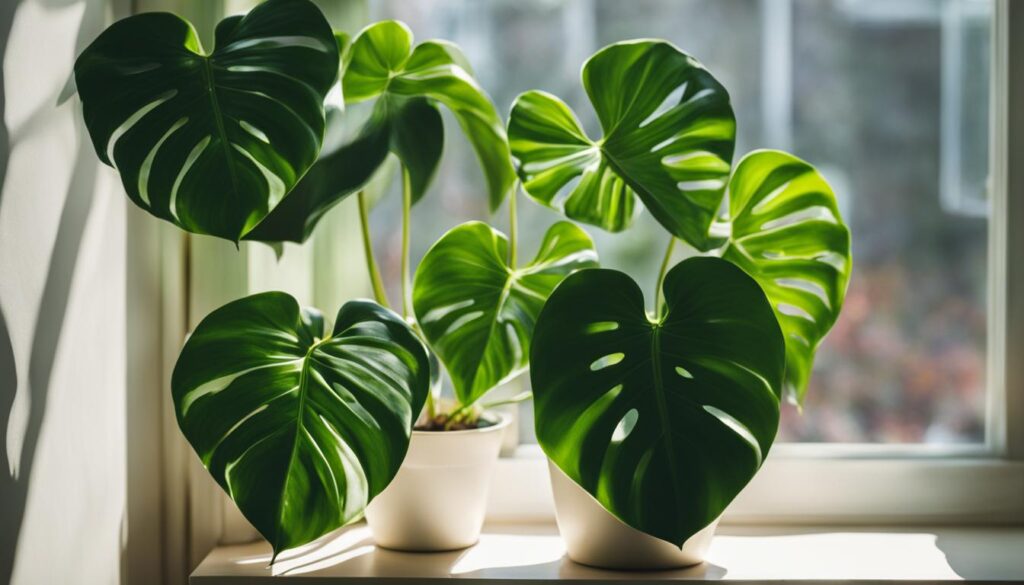
The heart-leafed philodendron (Philodendron hederaceum) is particularly popular for its stunning foliage and its ability to thrive in low light conditions. Its trailing vines can gracefully cascade down from hanging baskets or climb up trellises, adding a touch of natural beauty to any space.
Whether placed in a spacious room, office, or even a dimly lit bathroom, philodendrons can thrive and create a refreshing ambiance. Their ability to tolerate low light levels and thrive in various environments makes them a versatile choice for plant lovers who want to add greenery to their indoor spaces.
If you’re looking for a low maintenance, heart-leafed plant that can thrive in low light, the philodendron is definitely worth considering. With its lush foliage and easy care requirements, it is sure to bring life and beauty to any space.
Boston Fern: A Lush Addition to Low Light Rooms
How Boston Ferns Thrive in Moist, Low Light Environments
Boston Ferns, with their delicate fronds and lush greenery, are an excellent choice to bring a touch of elegance to any low light room. These versatile plants not only add visual appeal but also have the ability to thrive in environments with limited sunlight.
The Boston Fern, also known as Nephrolepis exaltata, is native to tropical regions and is highly adaptable to various conditions. It has developed specific characteristics that allow it to flourish in low light settings, making it an ideal choice for rooms with limited natural sunlight.
One of the key factors that contribute to the Boston Fern’s success in low light environments is its preference for high humidity. These plants thrive in moist conditions, which mimic the humid conditions found in their natural habitat. It helps to place the fern in a room with higher humidity levels or to regularly mist the leaves to maintain the required moisture.
In addition to their low light tolerance and love for humidity, Boston Ferns also have fantastic air-purifying properties. They can help improve indoor air quality by naturally filtering out toxins and pollutants, enhancing the overall well-being of your indoor space.
To care for your Boston Fern, ensure that it receives regular watering to keep the soil consistently moist but not waterlogged. They prefer indirect light but can tolerate some morning or evening sun, as long as it is not too intense. Avoid placing them in drafty areas as they prefer stable temperatures.
Overall, Boston Ferns are a beautiful choice for anyone looking to add a touch of lushness to their low light rooms. With their ability to thrive in moist and low light conditions, these ferns are a perfect addition to any space in need of some greenery and vitality.
Cast Iron Plant: The Indestructible Low Light Option
If you’re looking for a low light plant that can withstand even the toughest conditions, look no further than the Cast Iron Plant. As its name suggests, this plant is known for its remarkable durability and ability to thrive in low light environments.
The Durability and Adaptability of Cast Iron Plants in Low Light
The Cast Iron Plant (Aspidistra elatior) is an evergreen perennial that is native to Asia. It gets its name from its ability to withstand a wide range of conditions, including low light, neglect, and even drought. This makes it a perfect choice for busy individuals or those who are new to plant care.
One of the key features of the Cast Iron Plant is its tough, glossy, dark green leaves that can withstand dust, pollutants, and pests. This plant is also known for its ability to adapt to different light levels, making it a versatile option for various indoor spaces.
Cast Iron Plants can survive in low light conditions where other plants may struggle to thrive. They can tolerate shade and can be placed in areas with indirect or filtered light, making them suitable for offices, hallways, or even rooms with limited natural light.
Not only are Cast Iron Plants resilient and adaptable, but they also add a touch of elegance to any space with their unique appearance. Whether you choose to place them in a stylish pot or use them as a backdrop in your interior design, these plants are sure to enhance the aesthetic appeal of your low light room or office.
If you’re looking to add a low maintenance plant to your collection or want to introduce some greenery to your low light space, the Cast Iron Plant is an excellent choice. Its durability, adaptability, and aesthetic appeal make it an ideal option for both beginner and experienced plant parents alike.
English Ivy: The Classic Low Light Trailing Plant
When it comes to low light trailing plants, English Ivy is a classic choice that never disappoints. With its charming characteristics and ability to thrive in dimly lit spaces, this versatile plant is a favorite among both beginner and experienced plant enthusiasts.
English Ivy, scientifically known as Hedera helix, is known for its trailing vines and lush green foliage. Its adaptability makes it a great option for various low light environments, including offices, living rooms, and bedrooms.
The Charming Characteristics of English Ivy in Low Light Spaces
English Ivy possesses several charming characteristics that make it an excellent choice for low light spaces:
- Trailing Vines: English Ivy’s cascading vines add elegance and a touch of nature to any room. Whether placed on a high shelf, hanging basket, or cascading down from a bookshelf, the trailing vines create a visually appealing display.
- Tolerance to Low Light: English Ivy can thrive in low light conditions where other plants may struggle. Its ability to adapt to low light makes it perfect for areas with limited access to natural sunlight.
- Air Purifying Qualities: English Ivy is known for its air purifying properties. It can help remove toxins and improve indoor air quality, creating a healthier environment for you and your loved ones.
- Easy Care: English Ivy is a low maintenance plant that requires minimal attention. It thrives in average room temperatures and prefers slightly moist soil. Regular watering and occasional misting will keep your English Ivy happy and healthy.
Whether you’re looking for a plant to add beauty to your office, bring life to your living room, or enhance the ambiance of your bedroom, English Ivy is a versatile option that will thrive in low light spaces. Its charming characteristics and ease of care make it a popular choice among plant enthusiasts.
Dracaena: The Striking Tall Plant for Dim Corners
When it comes to adding a touch of drama to your low light areas, Dracaena plants are the perfect choice. With their tall stature and stunning foliage, they effortlessly command attention in any room. Dracaenas are known for their ability to tolerate low light conditions, making them the ideal solution for those dim corners that often get neglected.
The dramatic height of Dracaena plants creates a visual impact that instantly elevates the ambiance of any space. Their long, slender leaves cascade elegantly, adding a touch of elegance and sophistication. Whether you place them in a spacious living room or an office lobby, Dracaenas become the focal point of the room, drawing the eye upward and creating a sense of vertical space.
One of the advantages of choosing Dracaena for low light environments is their ability to thrive in indirect sunlight. They are highly adaptable and can tolerate a variety of light conditions, from bright indirect light to low light areas. This makes them an excellent option for rooms with limited natural light or spaces shaded by surrounding buildings.
Dracaena plants are not just visually striking; they also offer additional benefits for your indoor space. They help to purify the air by removing harmful toxins, improving the overall air quality and creating a healthier environment. Their lush foliage acts as a natural humidifier, releasing moisture into the surrounding air and reducing the dryness often associated with indoor spaces.
With several varieties to choose from, including the popular Dracaena marginata and Dracaena reflexa, you can find a Dracaena plant that perfectly complements your decor style and personal preferences. From the spiky leaves of the Dracaena marginata to the broad, lance-shaped leaves of the Dracaena reflexa, each variety offers its own unique charm.
So, if you have a dim corner that needs a touch of green and a dramatic impact, consider adding a Dracaena plant. With its striking height, lush foliage, and ability to tolerate low light conditions, it will transform any space into a captivating oasis.
FAQ
How do I determine the light levels in my space?
To determine the light levels in your space, you can use a light meter or simply observe how much natural light enters the room. If you have a lot of windows, it is likely that the space receives moderate to bright light. On the other hand, if your space is far from windows or has small windows, it is considered low light. You can also assess the intensity of light by noticing the shadows cast by objects in the room.
What are the benefits of Pothos in low light environments?
Pothos is a perfect low light trailing plant for several reasons. It thrives in indirect, low light conditions and can tolerate long periods without direct sunlight. Pothos also purifies the air by removing toxins such as formaldehyde and benzene. Additionally, this versatile plant is easy to care for and requires minimal effort to maintain its lush green leaves.
How do Spider Plants thrive in low light conditions?
Spider Plants are known for their adaptability and ability to survive in low light conditions. They have long, arching foliage that can tolerate a variety of light levels. In low light environments, Spider Plants have the ability to produce chlorophyll and thrive through the process of photosynthesis. This allows them to grow and thrive without direct sunlight, making them an ideal choice for hanging baskets in low light areas.
What are the stunning features of Peace Lilies in low light?
Peace Lilies are renowned for their elegant, white blooms and lush green foliage. In low light environments, they can still produce beautiful flowers and maintain their vibrant foliage. These large plants are not only visually appealing but also help purify the air by removing common indoor pollutants. Peace Lilies are relatively low maintenance and can tolerate low light conditions, making them perfect for adding a touch of elegance to any room.
How do Snake Plants thrive in low light conditions?
Snake Plants, also known as Mother-in-Law’s Tongue, are renowned for their ability to thrive in low light conditions. These tall plants have long, upright leaves that store energy, enabling them to survive with minimal sunlight. Snake Plants are natural air purifiers and can effectively filter out toxins like formaldehyde and xylene. With their low maintenance nature and unique aesthetic, Snake Plants are an excellent choice for any low light space.
Why are ZZ Plants perfect for low light office environments?
ZZ Plants are the ultimate low maintenance office plants that do exceptionally well in low light conditions. These plants have glossy, dark green leaves that can tolerate low light and thrive with minimal care. ZZ Plants are also known for their air-purifying qualities, making them an excellent addition to any office space. They are resilient to neglect and can survive in areas where other plants might struggle, making them a popular choice for busy professionals.
What are the lush foliage and easy care of Philodendrons in low light?
Philodendrons are beloved for their heart-shaped leaves and lush, tropical foliage, making them an excellent choice for low light environments. These plants have the ability to adapt to different light conditions, including low light areas. With minimal care, Philodendrons can thrive and grow in low light, making them an ideal plant for adding beauty and greenery to any space.
How do Boston Ferns thrive in moist, low light environments?
Boston Ferns are popular indoor plants that can thrive in both low light and high humidity environments. They have delicate, feathery fronds that can tolerate low light conditions and prefer moist soil. Boston Ferns are excellent choices for bathrooms, as they enjoy the humidity that often accompanies these spaces. With regular misting and waterings, Boston Ferns can flourish and bring a lush, vibrant touch to any low light room.
What is the durability and adaptability of Cast Iron Plants in low light?
Cast Iron Plants are renowned for their durability and adaptability to various light conditions, including low light areas. They have dark green, leathery leaves that can withstand neglect and low light levels, hence the name “Cast Iron.” These plants are excellent choices for those who want a low maintenance option that can tolerate challenging growing conditions. Cast Iron Plants are the perfect choice for anyone looking to add greenery to a dark corner or low light room.
What are the charming characteristics of English Ivy in low light spaces?
English Ivy is one of the classic low light trailing plants known for its charming characteristics. This vine-like plant has small, evergreen leaves that cascade beautifully, making it a popular choice for hanging baskets in low light areas. English Ivy is capable of thriving in shady conditions and is relatively low maintenance. It can bring a touch of elegance and natural beauty to any low light space.
What is the dramatic height and foliage of Dracaena in low light areas?
Dracaena plants are known for their striking height and dramatic foliage, making them an excellent choice for dim corners in low light areas. With their long, sword-shaped leaves, they can create a sense of verticality and add visual interest to any room. Dracaenas have the ability to tolerate low light conditions and require minimal care, making them an ideal low light indoor plant option for those who want to make a statement.


